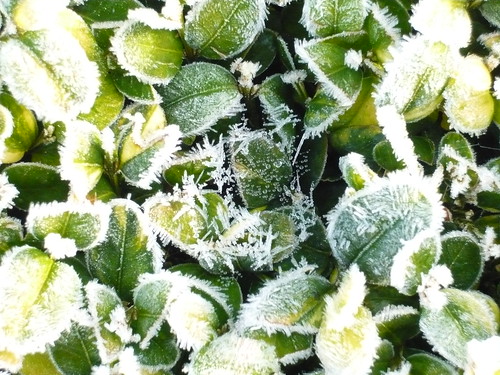Garden Frost the Pros and Cons
frost can strike when gardeners least expect it. Like boy scouts ‘be prepared’.
Frost is not all that bad particularly when it happens at the right time of year. It can play havoc at the wrong time of year but first we will look at what good can be achieved with frost.
The Pros of Frost
- Frost can kill off aphids and winter bugs in the garden. For bugs that burrow into the soil you need a prolonged hard frost and then it gets a bit more iffy.
- The first frost is a signal of seasonal change. Nature is warned winter in nigh and can take appropriate action. It is unfair for plants to continue growing into winter if they need a seasons rest.
- Frost can help wake the dormancy of some seeds and the improve the health of roots on some bulbs and perennials.
- Frost can help winter vegetables like Brussel Sprouts to improve their sweetness and flavour.
- Frost will break down the clods of soil in your vegetable garden if it has been dug over and left in lumps.
- Frost decorates the edges of dead grass, seedheads and stems and can be a design feature in a cold garden.
The Cons of Frost
- Fruit tree buds and blossom can suffer frost damage and reduce your crop.
- The buds of Magnolia and Camellia can easily be damaged by frost particularly if the early morning sun melts the frost too quickly.
- Plants should not be planted into frosty soil as a chill will give them a severe set back or kill them.
- If shrubs or trees arrive at the wrong time ‘heel them in’ or cover with sacking until there is a gap in the frosty conditions.
- Frost can kill half hardy annuals – be patient! Plant later they will catch up.
- Young or sappy growth can be blackened by frost without the plant being killed. In spring trim off the damage.
- Frost discourage armchair gardeners but provides a time to tidy the shed or greenhouse.
Frost Prevention Measures
- Frost will slow or stop a compost heap from decomposing. Cover the top and insulate the sides to retain heat.
- Outdoor taps can freeze up so lag your taps and pipes. Drain pipes and areas that do not need water through winter.
- Keep and use a good supply of horticultural fleece to cover buds and early flowers.
- Frost gathers in low lying pockets. Cold air runs down hill. Do not plant tender plants in frost pockets or keep pots etc at the foot of slopes.
- Use the walls and eves of houses as gentle protection from severe frost.
- Read Frost Damage to Plants
- Stop ponds containing fish from freezing over by gentle agitation or a heater

More about frost in the garden including late frosts and frost pockets.
The UK has suffered severe frosts even in the middle of May. This was the norm several decades ago and gardeners may have been lulled into a false sense of security.
May Frost Problems
- Most plants will recover with some warm weather but may be late or produce poorer results.
- Potato plants may have been nipped but should regrow.
- Bedding plants, beans and tomatoes could be restarted because there is plenty of time for new seedlings to catch up.
- Apple and fruit blossom will have damaged the crop for this whole year. (Any fruit that survives should grow larger).
- My early Rhododendrons were decimated just as the colours were looking spectacular (Still there is always next year)
Other Frost Damage
- Plants that have been totally ‘crisped’ will need to be replaced.
- I lost several semi-tender shrubs to the winter frosts, they were ‘well dead’ by May. This included Ceanothus, Abutilon and Cystus.
- Frost can recur into mid June so keep some horticultural fleece or bubble wrap handy.
- Harden off your seedlings – you know it makes sense!

Prune Favourite Shrubs After Frost Damage
- Tough stem tissue and buds further from the tips withstand more damage than soft leaves but are not immune if the temperatures are lower and the duration is longer.
- The more severe the damage, the longer it takes to regenerate so patience is needed to be sure you’ve located all the damage.
- Find the point down the stem where the frost damage ends, and cut down to half an inch above the nearest healthy bud.
- I am tempted to leave frost damage on the plant until new growth covers the unsightly mess on the basis it can’t get much worse. It may also offer a bit of protection against further frost. I am leaving my sad looking Hydrangeas alone for a while.
Winter Frost Damage
- Begonia plants are often the first to succumb to air frost. Get the corms inside and protected for winter before the ground is also frozen.
- Dahlia leaves go black as soon as they are bitten by the frost bug. Then is the time to cut down the haulms and dig up the tubers for winter storage in dry frost free conditions.
- Frost damage soft tissue like Annuals, Begonias and Dahlia leaves can still be composted.
- Do not forget to protect your containers that are not frost proof. Also lift all containers off direct ground contact or the bottom will freeze and may fall off the pot.





2 thoughts on “Garden Frost the Pros and Cons”
Comments are closed.